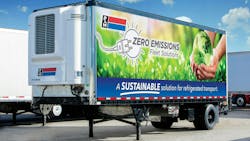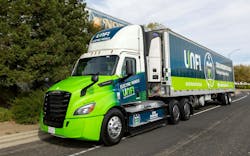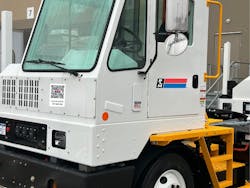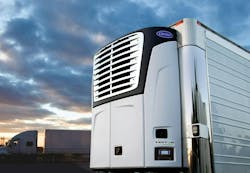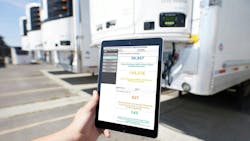Alternative acceptance: The pain is real, but the TRU transition is undeniable
The California Air Resources Board’s (CARB’s) zero-emission proposals, and the eagerness of federal and state agencies to embrace them, have caused refrigerated vehicle operators grief for years. Decades even. CARB adopted its first Airborne Toxic Control Measure (ATCM) for In-Use Diesel-Fueled Transport Refrigeration Units (TRUs) order nearly 20 years ago—way back in December 2004.
But many TRU users only now are reaching the final stage of this painful process.
“I’ve noticed the biggest change in acceptance over the last eight months,” said Alan Gassler, a zero-emission sales and operations analyst for PLM Fleet, which specializes in reefer equipment. “I have customers who weren’t considering the transition 16 months ago now calling me and saying, ‘Let’s do this.’ So perception is changing, and a lot of it is the realization that, ‘Hey, this is happening,’ and if you’re not one of the first movers, you could get left behind due to overall supply and demand.”
A California court in December barred CARB from collecting TRU fees starting this year, but the board’s first TRU registration and compliance deadline still went into effect Dec. 31, 2023. It required fleets with four or more “truck TRUs,” or the units built for medium-duty straight trucks, defined as “refrigeration units that are mounted on or in a truck cargo box that is permanently attached to a truck,” that operate in California to convert 15% of them to zero-emission units—and 30% by the end of this year.
All truck TRUs operating in California must be zero-emission reefers by Dec. 31, 2029.
“This advances faster than the Advanced Clean Fleets rule [which targets 2035 for complete adoption of zero-emission trucks],” said Bill Maddox, Carrier Transicold senior product manager. “So fleets will have to make a decision. Do they invest in fully all-electric vehicles, so the truck and the reefer unit, or do they continue to use an internal combustion engine in the vehicle but an all-electric TRU?”
Currently, CARB is regulating truck TRUs. Maddox expects to see movement on new trailer TRU rulemaking later this year. In addition, programs like the South Coast AQMD’s Warehouse Actions and Investments to Reduce Emissions (WAIRE) Program are forcing warehouse operators to consider hybrid or electric TRUs today as a way to earn “points” for reducing associated truck emissions and avoid paying “mitigation fees.”
And the Clean Fleets and Clean Trucks rules don’t apply only to operators in California. Eighteen states had adopted similar zero-emission vehicle measures as of January, and more states plan to follow suit, including surprising ones like Texas and Arkansas, Gassler said.
Still, many fleets are determined to deny electric TRU pain as long as possible.
“There isn’t enough electric capacity at our shippers and receivers for there to be any value in them,” said Ed Nagle, president and CEO of Ohio-based refrigerated transporter Nagle Companies. “And we’re not storing trailers with product here either, so for our operation, incorporating electric reefers doesn’t make sense.”
‘A very real challenge’
Maddox and Gassler say they see plenty of fleets taking similar stances, but others are equally determined to adopt early. That’s why Carrier and PLM continue to serve both parties. Carrier is advancing its CARB-compliant diesel TRUs and expanding its Vector line of hybrid and all-electric reefers, and PLM boasts “thousands” of hybrid units in its fleet of 15,000 refrigerated trailers for lease or rental.
However, only 200 of PLM’s TRUs are electric because adoption remains a challenge.
Compared to their diesel-powered counterparts, battery-electric reefers are 40-50% more expensive and “significantly” heavier, which is “a real problem,” said Don Durm, PLM VP of strategic customer relations. So is range anxiety, especially when it comes to drivers’ hours of service, and dreaded detention time.
“That’s absolutely a big one, especially if you have a lot of routes where you’re consistently going over and over again,” Gassler said. “If you don’t have the infrastructure to accommodate a fast charger, similar to what you have for a Tesla, that’s going to be very difficult.”
Manufacturers don’t yet have the capacity to meet the mandated demand for “eTRUs,” Durm maintained, which is why he argues against zero-emission programs that encourage participants to dismantle diesel equivalents. And even if OEMs could keep up, it’s unlikely utility providers and charging station installations will, he added. According to a 2022 report from the American Transportation Research Institute, the 12.3 million medium- and heavy-duty trucks in the U.S. would require 553 billion kW of electricity for charging daily—or about 14% of all current U.S. capacity—and 40,000 new charging stations.
“There’s a very real challenge there,” Durm said.
And those are the known challenges. Will frigid winter temperatures drain TRU batteries like they did Tesla batteries in January? Will they degrade over time like cell phone batteries? Only time will tell, Gassler said.
“We won’t know for sure until we’re eight or nine years down the road, and we start to see what wear and tear is doing to these batteries,” he said. “It’s a completely different space that’s never been tested, with vehicles constantly going over the road and consistently running 15-20 hours straight.”
Fleets’ cooler TRU future
Fortunately for reefer fleets, TRU technology is advancing rapidly, and competition is fueling innovation in hybrid, electric, and alternative energy-powered units like the Dearman system, which uses liquid nitrogen as TRU fuel and refrigerant. Advanced Energy Machines offers a solar-powered reefer, Carrier Transicold’s eCool system with ConMet’s Preset Plus eHub uses in-wheel electric motors to capture energy, and new U.S. player Cargobull North America recently introduced new hybrid TRUs for Utility trailers.
“I don’t think we’re at the end solution, but we’re trending in the right direction,” Gassler said.
Battery capacity is improving; most factory warranties cover eTRUs for 8-10 years, which should alleviate concerns over battery degradation; and all-electric units already are helping fleets reduce their carbon footprint and save money on diesel fuel, Gassler said.
“The biggest benefit is the cost of fuel vs. the kWh right now,” he shared. “That’s the most astronomical and apparent advantage when you do your ROI conversions. Another benefit is there are fewer components on eTRUs than on their diesel counterparts, so we see fewer maintenance events, due to them having fewer moving parts.”
Fleets also can help customers meet sustainability goals. Choosing highly efficient, all-electric TRUs that are quieter than diesel units can subsequently positively influence public and investor perception, Durm said.
“I have customers who are converting strictly because the neighborhoods in which they operate want to kick them out because they’re too loud in the mornings while making those grocery store and coffee shop deliveries,” Gassler said.
Path to sustainable success
The keys to a successful zero-emission TRU transition include stakeholders working together; diesel, hybrid, and electric options for every refrigerated transportation application; and advanced telematics capabilities, like geofencing and predictive maintenance, that unlock “smart” operation. Carrier Transicold offers Lynx Fleet telematics, Thermo King offers TracKing, PLM offers ColdLink, and all three work with third-party telematics providers to integrate critical data.
“I try to make it easy for everyone to work together—with the end goal of getting customers to adopt EV fleets,” Gassler said.
OEMs and dealers also play an important role. Thermo King recently introduced a new Electrification Readiness Program for dealers, and Carrier Transicold trains dealers to diagnose and maintain eTRUs. PLM helps fleets develop standard operating procedures, like plugging in at the end of the day, unplugging before driving away, and pre-cooling vehicles prior to loading.
“That’s going to give customers the best chance for success as they move into a zero-emissions world,” Maddox said.
PLM further assists fleets by letting them try expensive new tech before they buy it.
“We have a demo program where you can evaluate several different zero-emission products,” Gassler advised. “And those demos range from three to four weeks to one last year that lasted six months because we wanted to adapt to that customer’s needs. We also have to make sure there’s enough power on the grid so we can get energy providers involved and start looking for subsidy funding.”
Finally, the most crucial step to success is to accept that the electric TRU future has already arrived.
“The time is now,” Durm said. “This isn’t something you can wait on anymore.”
About the Author

Jason McDaniel
Jason McDaniel, based in the Houston TX area, has nearly 20 years of experience as a journalist. He spent 15 writing and editing for daily newspapers, including the Houston Chronicle, and began covering the commercial vehicle industry in 2018. He was named editor of Bulk Transporter and Refrigerated Transporter magazines in July 2020.
